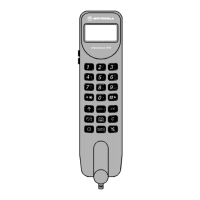OVERVIEW: Transmitter Path Section
Negative feedback is required to maintain system stability. Phase training is done to ensure that
the feedback is negative (180
º
). The phase shift of the loop consists of the sum of the delays
of several modules and components.
Operation of the Sledgehammer in a closed loop system requires the phase of the feedback
path to be adjusted with respect to the forward path such that the demodulated feedback
signal is the correct phase at the summing junction. This adjustment needs to take place
before the loop is closed and data is transmitted, and is referred to as the 'phase training
period'.
The maximum peak input signal to Sledgehammer is also scaled via the Roadrunner/DSP to
insure that the maximum input signal in the data will not cause clipping to occur in the
power amplifier output as a result of temperature/voltage gain variation in the forward path
(primarily the power amplifier). The scaling of the input signal is a result of 'level training'
which is performed in the transmit slot prior to data transmission. When level set training
was implemented on the Tranlin and ODCT IC, training was done autonomously on the IC.
Most of the level set circuitry was removed on the JANUS for cost savings.
SLEDGEHAMMER training methods will be based on the JANUS design. The scaling of the
input signal and the ramping is now performed by the DSP.The ramp signal will be applied
from the DSP, and will go through the signal path of the Roadrunner IC with the gain set
to maximum. The loop will be closed, but the slew rate limiter will be in a low gain (low
slew) mode. A counter on the Sledgehammer will begin counting from the beginning of the
timing event associated signal 'LAGC' and its' associated timing parameter "D". The loop
will perform an AGC function in the beginning portion of the ramp in order to set the loop
gain and then hold this gain value.
When the clip detect comparator determines that the loop can no longer compensate for the
PA, it will disconnect the Roadrunner input and allow the slew rate limiter to ramp the
signal down in a controlled manner to prevent splatter. After clip has been detected, and
before the beginning of data, a SPI read is necessary for the DSP to find out at what point
in time the clip occurred. Based on this information, a reference level will be set in the
Roadrunner. Providing level set in this manner will require at least two SPI activities. The
first activity is to read back the timing value "D" from the Sledgehammer IC. The second
is to write the gain setting for the Roadrunner.
Both phase and level training are required at least once before transmission of the data in
the first slot, but not necessarily performed in every transmit slot. DC training will be
performed at the start of every SLOT. All timer values associated with SLOT rising edge
will be increased with respect to JANUS program values to account for the DC training
time.
Unlike JANUS, Sledgehammer provides the ability to terminate the level training ramp by
either the internal Sledgehammer clip detector or an external control digital signal
V_TERM. V_TERM indicates when the battery current exceeds 3 Amps, which is used to
terminate the training ramp to avoid an early radio shutdown during level training.
Shutdown is avoided by lowering the transmit power when V_TERM is detected. This
signal goes directly to the levelset circuitry.

